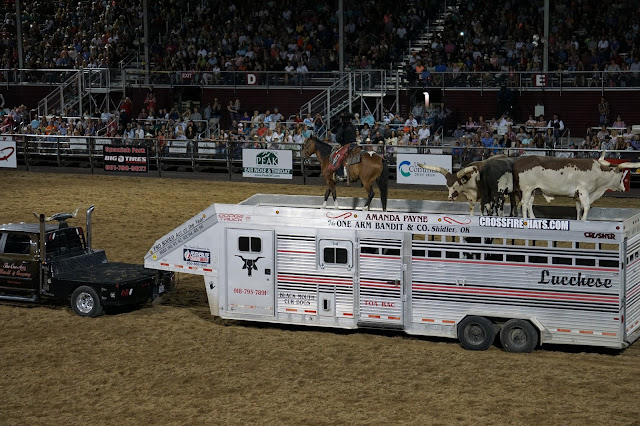I always wanted to
go to a rodeo but in all my years of living in America, I've never
been to one. This summer while we were vacationing in Utah, they had
a couple of big rodeo events, and so we bought the tickets to the
Fiesta Days Rodeo in Spanish Fork.
 |
| New Rodeo stadium in Spanish Fork, Utah |
The Spanish Fork Fiesta Days Rodeo is held every July and has been a
Fiesta Days Tradition for over 70 years. World champions compete
using a back-to-back format. The twelve fastest contestants during
each morning move to the evenings performance allowing the
audience to see the best contestants each night as well as a
potential event winner any given night. Spanish Fork Fiesta Days
Rodeo was also voted the #1 Rodeo in the Intermountain Area in 2014.
Pretty cool!
 |
| Nika, Brennen, and Lina watching the rodeo. |
 |
It doesn't matter what we are doing, these two are always having fun.
|
We went with our family,
my sister-in-law and my nephew on July 21, the first night of the
Rodeo. The stadium was full! We got there about 45 minutes early, so
we could find some parking and were entertained by mutton bustin' done
by little kids (some of them were as little as 5-year old!)
 |
| See the flying hat! |
 |
| See the flying boot and the flying kid! |
 |
| This one won the competition! We noticed that if the kids rode backwards, they could hang on a lot longer. |
 |
| All the sheep that lost their riders would gather together in one spot. |
Then the Rodeo started
with the opening ceremonies.
 |
| Rodeo committee and royalty |
 |
| Bringing the American flag |
The first event was
Bareback
Bronc Riding where the rider attempts to stay on the bucking horse
for 8 seconds without touching the horse with his free hand. It was
pretty impressive.
 |
| Here are the guys getting the rider off the bucking horse after he stayed on it for 8 seconds. |
Then
they had steer wrestling in which a horse-mounted rider chases a
steer, drops from the horse to the steer and wrestles it to the
ground by twisting it's horns.
Team
roping in which there are two mounted riders The first roper is referred to as the "header", the person who ropes the front of the steer, usually around the horns, Once the steer is caught, the header must dally (wrap the rope around the rubber covered saddle horn) and use his horse to turn the steer to the left. The second is the "heeler", who ropes the steer by its hind feet after the "header" has turned the steer. Team roping is the only rodeo event where men and women compete equally together in professionally sanctioned competition, in both single-gender or mixed-gender teams.
Saddle
bronc riding.
Women's
barrel racing is a rodeo event in which a horse and rider attempt to complete a cloverleaf pattern around preset barrels in the fastest time. It is usually done by women.

 |
| Look at that sharp turn! |
And
finally bull riding. It was really hard to get a good picture of this
particular event because riders didn't stay long enough on the bull
(and we didn't have a really good view of them).
 |
| Run for dear life! |
They
also had a rodeo clown who was actually really funny and entertained
us in between the events.
One
of my favorite shows was the one with Texas longhorns performed by
“One Armed Bandit”. The rider rounded up these beautiful animals on
the top of a huge trailer!
 |
| They are beautiful and mighty beasts! |
 |
| I just love the pattern on their backs |
 |
| Holly cow! Really! |
We
had a great time!
 |
| I took this picture at sunset during the rodeo. I just love it! |



























































